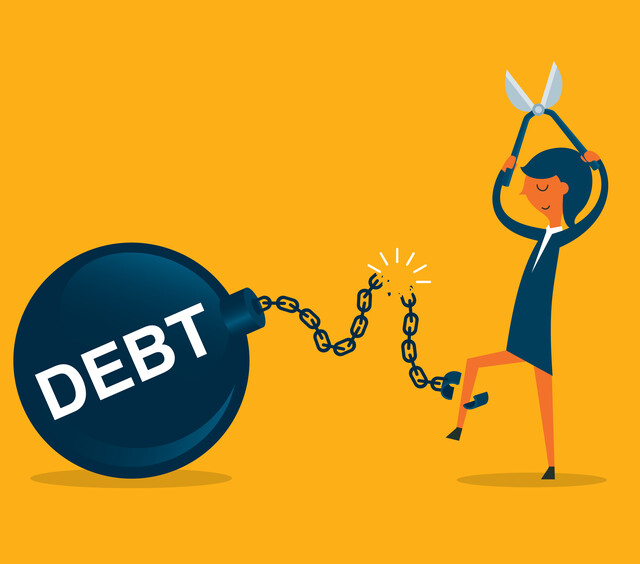I. Objectives
- Defining cost of capital
- Concepts of Cost of Debt and Cost of Equity (borrowing capital)
- Calculating expected returns
- Basics of capital structure
- Using the Modigliani-Miller Theorem to determine the firm's value and cost of capital
The cost of capital is the cost of a firm's debt and equity funds, or the required rate of return on a portfolio of the company's existing securities. It is used to evaluate and decide new projects, as well as the minimum return investors expect from the invested capital.
The cost of capital is determined by computing the costs of various financing sources and weighing them proportionately, in balance, to their designated use in the capital structure. It is important to maximize the firm's value, while minimizing the cost of capital. Each capital structure component's cost is closely related to the valuation of that source.
The cost of capital may be computed using debt, equity, and weighted average formulas and is useful in making capital budgeting decisions. A proposal is not accepted if its rate of return is less than the cost of capital. Financial performance and investment acceptability may be determined from analyzing the discounted cash flows.
Debt and preferred stock carry inherent risk. The cost is directly related to the current yield, and debt is adjusted lower to reflect the tax-deductible interest. The cost of retained earnings of common stock is the current dividend yield plus anticipated future growth rate. Adjustments are typically made to the calculation to determine the cost of new common stock.
Capital structure elements are weighted to obtain a minimum overall cost. Debt (borrowing) may appear to be the least costly solution. Caution is advised, however, as excessive debt creates more risk, which in turn drives up costs of all financing sources. The debt component that results in the lowest overall cost of capital is preferred. Then, the weighted average cost of capital may be used as the discount rate to estimate the present value of future flows. It also helps ensure the firm is earning at least the cost of financing.
The firm's present rate of earnings is less when the cost of capital is high, which indicates there is more risk and that the capital structure is not balanced. Investors can expect higher rates of returns in such instances.
The marginal cost of capital is the capital raised within a given period. The marginal cost of capital increases as the amount of capital increases.
The marginal cost of capital is considered and calculated as the "last dollar of capital raised." That is, as the last of the retained earnings (equity) is depleted, the cost of financing goes up. Higher-cost, new common stock is substituted for retained earnings, using the appropriate debt-to-equity ratio, to maintain the most favorable capital structure.
Firms typically use debt or equity resources to expand the firm.
Debt is money borrowed that must be repaid with interest.
Equity is money that has been raised through stock options or other interests in the company.
The cost of capital sources varies and depends on the firm's particular operating history, profitability, credit riskiness, and so forth. New companies with limited operating histories will experience higher costs of capital, since investors will demand a higher risk premium.
COST OF DEBT
The cost of debt is interest paid on the amount borrowed. It is the interest rate on a risk-free bond whose duration is the same as the term structure of the firm's debt plus the default premium -- and default premium and risk increase as the debt increases.
ADVANTAGES
Raising debt capital is less complicated than raising (equity) capital from shareholders. There is no requirement to comply with state or federal securities laws and regulations. Nor does the firm need to have shareholder consensus before acting, or is it required periodically to update investors and shareholders on the status of the debt. Additional advantages of debt financing include the following:
More tax efficient than equity financing,
o Cost of debt is an after-tax cost (equal to the cost of equity).
o Interest (debt) expense is deductible.
o Dividends on common shares must be paid with after-tax dollars.
Lenders have no claim to equity in the company.
Lenders are only entitled to repayment of agreed principal, plus interest.
Ownership interest is not diminished by the debt.
A larger end gain is realized than if equity was sold to finance the growth, and
Principal and interest re-payments are structured (except for variable rates), and may be planned for and forecast.
DISADVANTAGES
An excess of debt results in high leverage, which in turn leads to higher lender interest rates necessary to offset the higher default risk.
DISCOUNTED TAX RATE
For profitable firms, debt is discounted by the tax rate. Since interest expense is tax deductible, the after-tax cost of debt is calculated as:
Yield to maturity = Debt x (1 - T)
Where:
T = The company's marginal tax rate
Debt x = Risk free rate
COST OF EQUITY
The cost of equity is money raised from shareholders by:
1. Issuing more shares to shareholders, or
2. Issuing shares to new shareholders, and the dividend (interest) paid is the cost of equity.
The rate of return that equity investors require is not as neatly defined as the return on debt is by lenders. The cost of equity is approximated by comparing the particular investment to other investments having similar risk profiles. A future dividend stream is estimated based on the firm's dividend history and an assumed growth rate. The calculated market capitalization rate is equivalent to the current market price. Firms' estimated "dividend paying capacity," that do not distribute dividend profits, is from average cash flow and net income, which are compared to dividends that another, similar firm distributes.
The cost of equity is approximated, using the Capital Asset Pricing Model (CAPM). Typically using common stock returns over time, CAPM associates the risk-return trade offs of individual assets to market returns, and operates only in a market of equilibrium. Stock prices and market indexes are readily available and efficiently priced.
The CAPM represents, "a linear relationship between individual stock return and stock market return over time." Using the Least Squares Regression formula:
Kj = ? + ?Km + e
Where:
Kj = Common stock return
? = "Alpha," the intercept on the y-axis (expected risk-free rate of return)
? = "Beta," the co-efficient (sensitivity to market movement)
Km = Stock market return (typically S&P 500 Index)
e = Error term
Perhaps a simpler version of the CAPM may also be expressed as:
Es = Rf + ?s (Rm – Rf)
Where:
Es = Expected return on a security
Rf = Expected risk-free rate of return in the relevant market
?s = Sensitivity to market risk for the particular security
Rm = Historic return of the equity market
(Rm – Rf) = Risk premium of market assets over risk-free assets.
CALCULATED RETURN
Expected return = Risk-free return + Security's sensitivity to market risk x Market risk premium
Return on equity (ROE) analyzes a firm's performance. It is the net income returned as a percentage of the shareholders' equity, and measures profitability according to how much profit is generated with the shareholders' invested money.
Net income is for the full fiscal year. It is the income -- after dividends are paid to preferred stock holders -- but before dividends are paid to common stock holders.
The shareholder's equity does not include preferred shares.
ROE = Net Income
CALCULATING EXPECTED RETURN ON BONDS
Bonds typically provide a reasonably consistent stream of income for long-term investing. Stocks are more volatile, whereas bonds have a guaranteed interest rate. The following are steps for calculating expected returns on bonds.
1. Determine the bond's par (the actual issue price).
2. The price paid for the bond is generally NOT the par price of the bond. The price, instead, depends on the current interest rate and the bond market.
3. Determine the applied interest rate.
The weighted average cost of capital (WACC) is also the firm's cost of capital. WACC is the minimum return the company must earn on an existing asset to satisfy whoever provides the firm's capital, such as lenders, creditors, owners, investors, and others. The firm proposed a target capital structure, defined as the combined debt, the preferred and common equity that maximized the stock price.
Firms raise capital from common and preferred stocks, straight, convertible, and exchangeable debt, options, government subsidies, and other sources. Different securities, financed from different sources, generate different returns.
The WACC is calculated using relative weights of each capital structure component. The WACC increases as the beta (sensitivity to market movement) and rate of return on equity increases.
Definitively, the WACC formula is the cost of each capital component times its proportional weight.
Where:
Re = Cost of equity
Rd = Cost of debt
E = Market value (of equity)
D = Market value (of debt)
TV = E + DE/V = Percentage of equity financing
D/V = Percentage of financing that is debt
Tc = Corporate tax rate
If the firm is only financed using market values of equity and debt, the average cost of capital is:
Where:
D = Total debt
E = Total shareholder's equity
Ke = Cost of equity
Kd = Cost of debt
Note: It is quite common to discount cash flows at WACC to determine the Net Present Value (NPV) of a project.
NPV = Present Value (PV) of the Cash Flows discounted at WACC
A firm's financial capital structure is determined by how it finances its assets using debt, equity, or other hybrid securities.
The capital structure basically consists of long-term liabilities, preferred and common stock, and retained earnings. There must be sufficient equity to ensure financial stability. Debt is typically leveraged to reduce returns on investments, while increasing returns to shareholders.
The value of the capital structure (represented on the Balance Sheet) includes contributed capital reported as profit from stock sales. Long-term liabilities are the present value of expected cash flows. Current liabilities are unadjusted values of money. Retained earnings summarize all the valuation income measures.
Equity investments are permanent financing that carries the greatest risk. Equity protects the firm from the unexpected and represents a certain safety margin for debt investors.
Invested long-term debt is fixed contractual debt payable at specified times, in specified amounts, which allows tax deductible ROI. Committed short-term debt is due to normal daily operations. They may be liquidated with cash and are included in any capital structure analysis.
A firm's capital structure influences credit risk. A firm with a conservative capital structure is a low credit risk, because it has minimal debt, low fixed-cost commitments, and a low probability of defaulting.
The Modigliani-Miller Theorem (M&M) assumes that the value of the firm and its cost of capital is independent of the means of financing. Essentially this means that the value of the firm and its cost of capital are not affected by the firm's capital structure.
The M&M Theorem initially stipulates the firm's value as:
Where: V = Value
EBIT = Earnings before interest and taxes
Ka = Cost of capital
And:
Where:
Keu = Cost of equity for a firm with zero debt
When the firm includes debt in its capital structure, the cost of equity increases by the risk premium needed to offset the risk associated with the debt.
KeL = Keu + Risk Premium
KeL = Keu + (Keu – I) (D/S)
Where:
KeL = Cost of equity for a firm with debt
I = Interest on debt
D = Amount of debt financing
S = Amount of equity financing (stock)
The important factor is, when there is a risk premium associated with the cost of equity financing, leverage is involved. The cost of capital cannot be reduced, nor is the valuation of the firm increased, due to the fact that any benefits from cheaper debt are offset by the increased cost of equity financing, denoted as: KeL = Keu + Risk Premium.





























